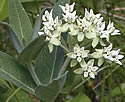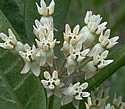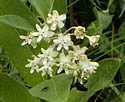Asclepias ovalifolia (Oval-leaf Milkweed)
| Also known as: | Dwarf Milkweed |
|---|---|
| Genus: | Asclepias |
| Family: | Apocynaceae (Dogbane) |
| Life cycle: | perennial |
| Origin: | native |
| Habitat: | part shade, sun; dry sandy soil, prairies, open woods, roadsides |
| Bloom season: | June - July |
| Plant height: | 10 to 24 inches |
| Wetland Indicator Status: | none |
| MN county distribution (click map to enlarge): |  |
| National distribution (click map to enlarge): |  |
Pick an image for a larger view. See the glossary for icon descriptions.
Detailed Information
Flower: 

![[photo of flowers]](/udata/r9ndp23q/pd/asclepias-ovalifolia-2-t.jpg) Flowers are about ¼ inch across and ½ inch or less tall, in a convex cluster typically under 2 inches wide. A flower has 5 petals spreading out and/or down that are white with pale green or pinkish purple tones, and 5 hoods and horns that are clear white. The hoods are about twice as tall as the center column. The entire flower fades to yellow with age. A cluster is at the top of the plant, with usually 1 or 2 clusters emerging from upper leaf axils.
Flowers are about ¼ inch across and ½ inch or less tall, in a convex cluster typically under 2 inches wide. A flower has 5 petals spreading out and/or down that are white with pale green or pinkish purple tones, and 5 hoods and horns that are clear white. The hoods are about twice as tall as the center column. The entire flower fades to yellow with age. A cluster is at the top of the plant, with usually 1 or 2 clusters emerging from upper leaf axils.
Leaves and stem: 

![[photo of leaves]](/udata/r9ndp23q/pd/asclepias-ovalifolia-3-t.jpg) As one of its common names implies the opposite leaves are decidedly oval shaped, a little broader at the base and narrowing at the tip and only 1 to 1½ inches wide and 2 to 3 inches long, on leaf stems about ¼ inch long. The main stem is slender but erect, unbranched with plants occuring in groups but emerging stems are singular. Entire plant covered in fine downy hairs.
As one of its common names implies the opposite leaves are decidedly oval shaped, a little broader at the base and narrowing at the tip and only 1 to 1½ inches wide and 2 to 3 inches long, on leaf stems about ¼ inch long. The main stem is slender but erect, unbranched with plants occuring in groups but emerging stems are singular. Entire plant covered in fine downy hairs.
Notes:
This milkweed is not uncommon but its small stature can make it difficult to spot until you realize where to look for it. It appears to easily re-colonize road margins in sandy soil types. Generally not found in the Arrowhead it can be found in most other areas of the state. All Asclepias were formerly in family Asclepiadaceae but have been reassigned to Apocynaceae (Dogbane).
Native Plant Nurseries, Restoration and Landscaping Services ↓
More photos
Photos by K. Chayka taken along Hwy 64 north of Leader, Cass County. Photos courtesy Peter M. Dziuk, taken at Cedar Creek Natural History Center and various state highway road rights-of-way in Hubbard and Cass counties
Comments
Have you seen this plant in Minnesota, or have any other comments about it?
on: 2013-03-26 00:48:41
Along Hy 210 west of Brainerd, near the rr tracks. A very nice attractive milkweed. I will try to get it established in my garden.
on: 2013-06-30 18:33:09
In ditch on Hwy 92 west of Trail, east of road to Fosston (350th Ave SE). More specificaly, just east of driveway into gravel pit directly across the road from a larger gravel pit.
on: 2016-07-05 09:23:48
Found this cute little Milkweed while walking into town along the bike trail just North of Nisswa. I just love the white milkweeds.
on: 2016-07-14 19:48:28
Found at the edge of hay field on our place, 07/14/16.
on: 2017-06-21 19:44:54
I just found this on my yard today. I have never seen it before and I know it was not blooming there last year or anywhere near my yard. I never mow this section of yard and it is fun to see what new things appear over time.
on: 2018-06-16 19:16:09
Smells wonderful!
on: 2018-06-26 12:55:40
First ever sight of this plant along our unpaved driveway.
on: 2022-03-15 13:42:44
Inquiring if this species has disappeared from it's southern MN range. Looks like all records shown are pre 1975. I've not seen it in SE MN, but it appeared fairly common when seen in the Brainerd Lakes area. Has its range shifted with land use changes/loss of native prairie?
on: 2022-03-15 15:10:00
Gabe, according to the Bell Museum's online atlas, there hasn't been a record of this milkweed in the southeast counties since the late 1990s, but one was reported in Cottonwood county in 2007 so there is hope it is still around somewhere. There is little doubt in my mind that development, agriculture and/or invasive species have degraded or destroyed its habitat.
on: 2023-06-25 08:21:22
I haven't noticed this species before - until this year! It is blooming like crazy along the Paul Bunyan bike trail - in dry, sandy areas with little competition from other plants. I have noticed adult monarchs fluttering around it, and lots of Monarch caterpillars, milkweed bugs, and ants! Really a pretty species that I could see incorporating into a short grass native planting.







 Oval-leaf Milkweed plant
Oval-leaf Milkweed plant more plants
more plants a roadside colony of Oval-leaf Milkweed
a roadside colony of Oval-leaf Milkweed